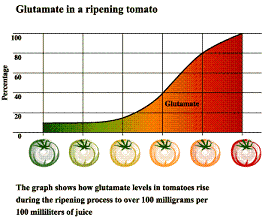Chef Brian Roland's
‘Cooking with Umami’
 Sweet, Salty, Sour, Bitter and….Umami? But I thought there were only four basic tastes that the human tongue receptors could recognize. Well now there’s a fifth, and it's causing some tasty controversy. Many specialists now believe that taste is actually more complicated, with the taste buds being helped along by sense of smell, by the feel of substances in the mouth
Sweet, Salty, Sour, Bitter and….Umami? But I thought there were only four basic tastes that the human tongue receptors could recognize. Well now there’s a fifth, and it's causing some tasty controversy. Many specialists now believe that taste is actually more complicated, with the taste buds being helped along by sense of smell, by the feel of substances in the mouth  and even by the noise that food makes when we chew it. This newly found taste, for a while was almost unexplainable, and a bit of a mystery. But in the early 1900s, Dr. Kikunae Ikeda of the Tokyo Imperial University, identified this taste when studying the flavors in seaweed broth. Ikeda isolated monosodium glutamate as the chemical responsible and, with the help of the Ajinomoto company, began commercial distribution of MSG products.
and even by the noise that food makes when we chew it. This newly found taste, for a while was almost unexplainable, and a bit of a mystery. But in the early 1900s, Dr. Kikunae Ikeda of the Tokyo Imperial University, identified this taste when studying the flavors in seaweed broth. Ikeda isolated monosodium glutamate as the chemical responsible and, with the help of the Ajinomoto company, began commercial distribution of MSG products.
So what is it, and how do I cook with it? It is actually not a physical ingredient, but more of a natural occurring amino acid that gives off a pleasant savory taste. They are found in many meats, vegetables, seafood and dairy. The word Umami is a Japanese word which means tasty, delicious, or yummy. It has also been associated with other words including meaty, brothy, and savory. Not everyone can differentiate the taste from the common four, but its popularity has become more widespread in recent years. For example, there is
 now a Umami Food and Art
now a Umami Food and Art
photo credit: Mimi Oka and Doug Fitch Festival in NY that is dedicated to educating culinary professionals and artists about this mysterious taste. Kikkoman’s Soy Sauce has begun an advertising campaign with top chefs from around the world using Umami as part of their slogan, to raise awareness of the uses of their soy sauce products to enhance the umami experience.
 As a professional chef, it is very important to create the full dining experience through the arousal of the senses. One of the largest contributors to that is taste, and the foundation of taste relies on the combination of flavors and ultimate balance. There are a few rules to balancing tastes, most of which are emotional, and all of which involve complete awareness of the ingredients at hand. Ingredients are never constant, they are always changing. Today a tomato may have more water in it than it will tomorrow, and the fresh basil just picked out of the garden may become a bit dull overnight. To fully balance a dish, we need to understand the tastes, temperatures and textures that go into the dish. Balancing hot and cold, or sweet and spicy, or acidic and salty, all involve a great deal of knowledge and awareness. All of this can be learned through practice and opening up your true senses. It took me years to understand ingredients, some of which I am still learning about every day.
As a professional chef, it is very important to create the full dining experience through the arousal of the senses. One of the largest contributors to that is taste, and the foundation of taste relies on the combination of flavors and ultimate balance. There are a few rules to balancing tastes, most of which are emotional, and all of which involve complete awareness of the ingredients at hand. Ingredients are never constant, they are always changing. Today a tomato may have more water in it than it will tomorrow, and the fresh basil just picked out of the garden may become a bit dull overnight. To fully balance a dish, we need to understand the tastes, temperatures and textures that go into the dish. Balancing hot and cold, or sweet and spicy, or acidic and salty, all involve a great deal of knowledge and awareness. All of this can be learned through practice and opening up your true senses. It took me years to understand ingredients, some of which I am still learning about every day.
 Taste and flavor are commonly associated as one in the same, but there is a definite distinction between the two. It is said that taste is the sensation caused in the mouth by contact with a substance, while flavor is the mixed sensation of both smell and taste. To simplify this research, it would be safe to say that the formula of taste + smell = flavor. Umami as an ingredient, becomes a flavor enhancer bringing depth to your food without covering any flavors or subtle tastes. It is found in more mature foods such as an older Parmesan cheese, aged wine, or soy sauce.
Taste and flavor are commonly associated as one in the same, but there is a definite distinction between the two. It is said that taste is the sensation caused in the mouth by contact with a substance, while flavor is the mixed sensation of both smell and taste. To simplify this research, it would be safe to say that the formula of taste + smell = flavor. Umami as an ingredient, becomes a flavor enhancer bringing depth to your food without covering any flavors or subtle tastes. It is found in more mature foods such as an older Parmesan cheese, aged wine, or soy sauce.
Umami rich foods are very satisfying, and can be a healthier way to cook as well. They tend to make salt taste saltier, which means we can lower the amount of sodium in a dish when using umami rich ingredients. It also creates a sensation that most chefs call "mouth feel," which is normally associated with the mouth sensation we get when we eat foods high in fat. Thus, we may lower the amount of fat in a dish, and let the richness of the umami do the trick.
 Here is a starter list of a few ingredients that are very umami rich, and would lend a great deal of taste and flavor to any home cooked meal.
Here is a starter list of a few ingredients that are very umami rich, and would lend a great deal of taste and flavor to any home cooked meal.
Seafoods: fish sauce, anchovies, kombu, nori, dried bonito flakes,  makeral, seabream, tuna, cod, prawns, squid, oysters, shellfish.
makeral, seabream, tuna, cod, prawns, squid, oysters, shellfish.
Meat: beef, pork and chicken.
Vegetables: dried and fresh shiitake mushrooms, corn, truffles, soy beans, potatoes, sweet potatoes, Chinese cabbage, carrots and tomatoes.
Others: parmesan cheese and green tea.
In conclusion, the ability to experience this so called fifth taste is totally dependant on one’s self awareness. Umami is a very powerful taste, one that will be researched and analyzed for years to come. The only way to become a better cook and be more aware, is to play with your food, so get to the store buy some Umami rich ingredienst and start cooking!
Email me via Contact by including "Chef Brian" in the subject line if you have any questions at all, or would like to share ideas or experiences.
For now, Good Luck and Good Eating!~Chef Brian


